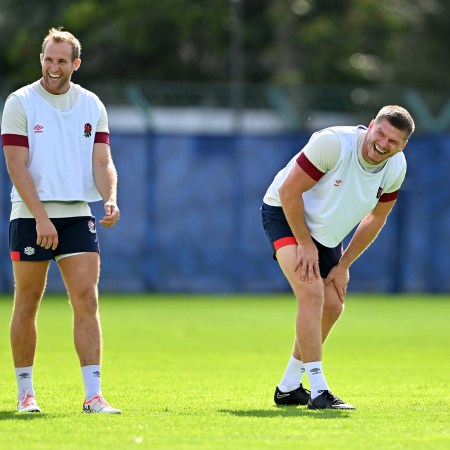As someone who regularly walks through Central Park, I can confirm that millennials get just as agitated as previous generations the second their kids start scrambling on the rocks. “Get down from there!” is alive and well.
But today’s tiny Tarzans — like yesterday’s — have the right idea. Exercise by way of exploration is just about the healthiest thing they could be doing for their developing bodies and brains.
Different actions arrive more naturally for different kids, of course (some are born to play shortstop, others content to pick dandelions in right field.) But those that do arrive should be encouraged…and learned from. That’s right: instead of chastising kindergarteners, adults should be emulating them, figuring out ways to incorporate their whims, inspirations and movements into our own fitness routines.
Obviously, there are certain advantages available to young children: their spinal flexibility is off the charts, they sleep well and they don’t know their playdough from the debt ceiling. But it’s possible to bottle their instinctive approach and channel it into your own relationship with wellness.
From playing to fidgeting to belonging, we break down why you should exercise like you’re five again. Stick to these credos and one day, you’ll be the grandparent calling up to the top of the rocks: “I’ll be right there!”
The 10 Best Breathing Exercises for Sleep, Fitness and Calm
There are a lot of tricks out there. Keep these in your toolkit.Play, play, play
We recently wrote about the simple power of putting aside a couple hours a week to shoot hoops. Here in adultdom, it’s proven surprisingly revelatory. But broaching basketball in such an academic way would be plainly alien to most children, who make time for balls, toys, blocks, or even video games (not always a bad thing…look to Mario Kart) without really thinking about it.
Play is as second nature to children as adults checking their emails in the morning. That’s a sobering simile, but that’s sort of the point. The same developmental benefits that children glean in body and brain from running around, inventing, making rules, and breaking them, can dramatically supplement overall well-being in adults. And in the same way that kids can be choosy about which play suits them best, you get decide which sort of play best suits your skills, interests or lifestyle.
Belong to something
Kids these days probably belong to too many things. That’s not their fault. On the absurd and growing list of “parenting type” monikers (helicopter, dolphin, snowplow) we have “outsourcing parents” — the sort of guardians who sign their kiddos up for schedules so packed they’d bring a tear to Mark Wahlberg’s eye. Think: soccer, tee-ball, Taekwondo, dance, chess, piano, etc., on repeat.
On some small level, it’s kind of impressive how much kids do. But that’s not the takeaway here — focus on how much they belong to. For those of you who find yourselves in and out of fitness slumps, year after year, join a community. I have adult friends who train at Jiu Jitsu academies, adult friends who run with track clubs, adult friends who have a standing date with a golf simulator in Brooklyn that allows you to “play 18” at iconic courses like Pebble Beach.
It all counts. And good news: as an adult — similar to choosing exactly how you want to play — you’re the master of your Google Calendar. You can slot games, classes or sessions in with a restraint that most 21st-century parents evidently lack. You don’t need to be always moving, but you do need to get moving. Committing to a community is a great way to start.
Curious George mentality
Fitness probably shouldn’t always feel adventurous or strange, but it’s a nice shock to the system to have a field trip once in a while. That might mean finding a hill in your neighborhood to run up and down, five times over. Or doing a barefoot workout at the beach. Or…scrambling rocks in Central Park. Look to the gravel biking community, or the rucking folks, or the people knocking out polar plunges. There’s a childish fervor at play there, a curiosity to see what’s on the other side of the hill, that can take trainees (a) stop stressing about the work to be done, and (b) start living for it.
Freedom to fidget
In their book Built to Move, mobility gurus Juliet Starrett and Kelly Starrett extoll the virtues of sitting on the floor for at least 30 cumulative minutes per day. When practiced regularly, seated positions are actually capable of restoring hip and low back function, stretching out tissue in the hamstrings and calves, and upping one’s “movement capacity,” a term to describe the degree of movement available to a person at a given time. Remember: the average American’s movement capacity has taken a hit in recent years, which is more or less the reason everyone’s back hurts.
Well, kids are really good at getting on the ground. That’s because the practice is learned — in pre-school and elementary school, you spend hours sitting cross-legged on a nylon carpet, or on a linoleum floor at assembly, listening to older people talk. Children are taught that “sitting still” throughout this is a sign of respect, but it’s actually impossible, and almost all of them fidget, shift their weight, scratch at themselves, or switch positions.
This is a good thing, and it’s something that adults should seek to replicate in their own lives, while watching TV, drinking tea, or talking on the phone. “We want you to fidget and change positions while on the floor because it gives you the opportunity to rotate your hips into different end ranges, take pressure off your tissues, and avoid stiffness and pain,” the Starretts write in their book. “Your brain is going to tell you to move around while you’re on the floor, and that’s exactly what we think you should be doing.”
“Autoregulation”
It’s a word that absolutely zero kindergarteners know…but the same might be said for a fair share of exercising adults. Autoregulation refers to the practice of adjusting the intensity and duration of your workout based on your body’s real-time feedback and energy levels. A crude example: I might have every intention of running six miles on an empty Sunday, then end up at a Taco Bell Cantina at 2 a.m. the night before after hours of karaoke. Chances are, the first mile of my run the next day won’t be me at my best. So I autoregulate — I shorten it, or I run it slowly, or I cancel it to stretch, breathe and detox instead.
Kindergarteners autoregulate on auto-pilot. Anyone who’s spent a day with a child has likely seen them run when they feel energetic and rest when they’re tired (with a bit of complaining spliced between the two). At the end of the day, literally, they respect their fatigue.
This is a critical lesson for trainees on another branch of the fitness tree. The ones who don’t need help starting, but have a hell of a time stopping, and are at risk of eventually incurring burnout or injury along the way. (We speak of the overtraining phenomenon.) Kids, meanwhile, know when they deserve a break. And most importantly: they’ll never fret over how an ice cream cone might destabilize their whole fitness routine. They’ll scarf it down, stress-free, and head to bed, a calendar of play to attend to the next day. That’s true wellness.
Whether you’re looking to get into shape, or just get out of a funk, The Charge has got you covered. Sign up for our new wellness newsletter today.

























